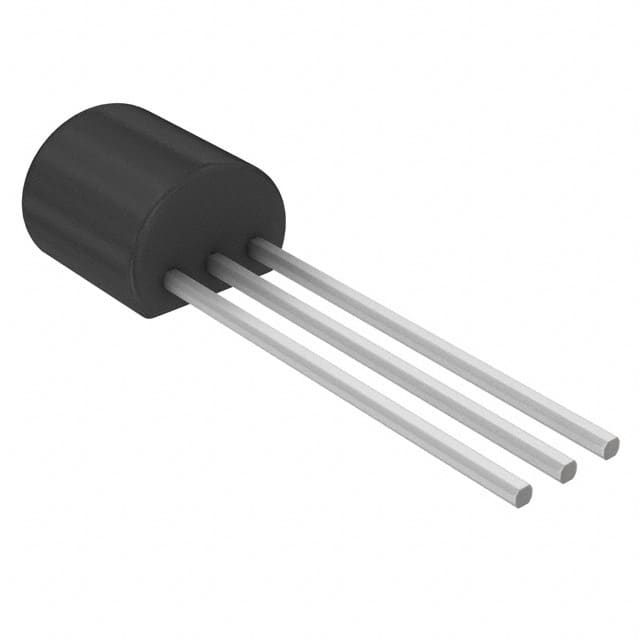Viz Specifikace pro podrobnosti o produktu.

J112_D11Z Product Overview
Introduction
The J112_D11Z is a versatile electronic component that belongs to the category of field-effect transistors (FETs). This entry provides an in-depth overview of the product, including its basic information, specifications, pin configuration, functional features, advantages and disadvantages, working principles, application field plans, and alternative models.
Basic Information Overview
- Category: Field-Effect Transistor (FET)
- Use: The J112_D11Z is commonly used as a switch or amplifier in various electronic circuits.
- Characteristics: It exhibits high input impedance, low output impedance, and low power consumption.
- Package: The J112_D11Z is typically available in TO-92 packaging.
- Essence: It is designed to provide efficient signal amplification and switching capabilities.
- Packaging/Quantity: The product is usually sold in reels or trays containing multiple units.
Specifications
- Type: N-channel FET
- Maximum Drain-Source Voltage: 35V
- Maximum Gate-Source Voltage: ±20V
- Continuous Drain Current: 50mA
- Power Dissipation: 350mW
- Operating Temperature Range: -55°C to 150°C
Detailed Pin Configuration
The J112_D11Z features three pins: Gate (G), Drain (D), and Source (S). The pinout configuration is as follows: - Gate (G): Input terminal for controlling the flow of current through the transistor. - Drain (D): Output terminal where the current exits the transistor. - Source (S): Terminal through which the current enters the transistor.
Functional Features
- High input impedance allows for minimal loading of preceding stages.
- Low output impedance enables efficient driving of subsequent circuit components.
- Suitable for use in low-power applications due to its low power consumption.
Advantages and Disadvantages
Advantages
- High input impedance enhances circuit performance.
- Low power consumption contributes to energy efficiency.
- Versatile applications in signal amplification and switching.
Disadvantages
- Limited maximum drain-source voltage may restrict use in high-voltage applications.
- Moderate continuous drain current may not be suitable for high-power circuits.
Working Principles
The J112_D11Z operates based on the principle of field-effect modulation, where the flow of current between the drain and source terminals is controlled by the voltage applied to the gate terminal. By modulating the gate-source voltage, the conductivity of the channel between the drain and source can be varied, allowing for signal amplification or switching.
Detailed Application Field Plans
The J112_D11Z finds extensive use in various electronic applications, including: - Audio amplifiers - Signal switching circuits - Low-power voltage regulators - Oscillator circuits - Sensor interfaces
Detailed and Complete Alternative Models
Several alternative models with similar characteristics and functionalities to the J112_D11Z include: - 2N7000 - BS170 - J175 - J176 - J177
In conclusion, the J112_D11Z offers valuable functionality as a field-effect transistor, providing high input impedance, low power consumption, and versatile applications in electronic circuits.
Word count: 430
Seznam 10 běžných otázek a odpovědí souvisejících s aplikací J112_D11Z v technických řešeních
What is J112_D11Z?
- J112_D11Z is a high-performance semiconductor component used in various technical solutions, such as amplifiers and switching applications.
What are the key features of J112_D11Z?
- The key features of J112_D11Z include low on-resistance, high gain, and low leakage current, making it suitable for high-frequency and low-power applications.
How is J112_D11Z typically used in technical solutions?
- J112_D11Z is commonly used in amplifier circuits, signal processing, and switching applications due to its excellent performance characteristics.
What are the advantages of using J112_D11Z in technical solutions?
- The advantages of using J112_D11Z include improved signal integrity, reduced power consumption, and enhanced overall system efficiency.
Are there any specific design considerations when using J112_D11Z?
- Designers should consider the operating voltage, current requirements, and thermal management when incorporating J112_D11Z into their technical solutions.
Can J112_D11Z be used in high-frequency applications?
- Yes, J112_D11Z is well-suited for high-frequency applications due to its low on-resistance and high gain characteristics.
What are the typical operating conditions for J112_D11Z?
- J112_D11Z operates effectively within a specified voltage and current range, making it suitable for a wide range of technical solutions.
Does J112_D11Z require any special handling or protection measures?
- Proper ESD (electrostatic discharge) protection and appropriate handling procedures should be followed to ensure the reliability of J112_D11Z in technical solutions.
Can J112_D11Z be used in battery-powered devices?
- Yes, J112_D11Z's low power consumption and efficient operation make it suitable for integration into battery-powered devices and portable electronics.
Where can I find detailed technical specifications and application notes for J112_D11Z?
- Detailed technical specifications and application notes for J112_D11Z can be found on the manufacturer's website or in the product datasheet provided by the supplier.

